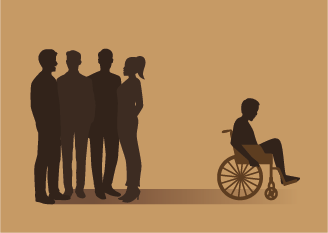
Medical model
This model believes that disability is a problem that needs to be fixed even if the individual isn’t suffering pain or discomfort.
This model only looks at what is wrong with the individual rather than what the individual needs to be able to live a full and rewarding life.
Where the medical model is used the individual is expected to adapt or is excluded.
Examples include:
- A child that uses a wheelchair would be excluded from any building or social space that didn’t have ramps as the wheelchair would be seen as the barrier rather than the lack of adequate access for wheelchairs.
- A child with diabetes would be need to fit in with the group in a health care setting during snack times or eat separately if they needed their snack at a particular time.
- A child with epilepsy would be unable to go on the rock climbing trip as the risks would be considered to be too great.
Social model
This model believes that the problem is with society and the way that it treats individuals with a disability. It views disability as simply a difference and believes that society needs to ensure that a disabled individual’s rights need to be supported.
Examples include:
- If a building had problems with access for a child that uses a wheelchair then this barrier should be removed by installing ramps so that everyone has equal access to the facilities offered.
- If a setting is aware that a child is diabetic and needs snacks at particular intervals throughout the day, they will ensure that the individual’s mealtimes cater to these needs.
- A child with epilepsy who wishes to take part in a rock climbing trip would be allowed to do so and the organisers of the trip would be required to carry out a risk assessment and ensure that appropriate support is put in place.
Model meddygol:
Yn y model hwn, credir bod yr anabledd yn broblem y mae angen ei datrys, hyd yn oed os nad yw'r unigolyn yn dioddef unrhyw boen neu anghysur.
Dim ond ar yr hyn sydd o'i le ar yr unigolyn y mae'r model hwn yn edrych, yn hytrach na'r hyn sydd ei angen ar yr unigolyn i allu byw bywyd cyflawn a llawn boddhad.
Lle y caiff y model meddygol ei ddefnyddio, disgwylir i'r unigolyn addasu, neu caiff ei gau allan.
Dyma rai enghreifftiau:
- Byddai plentyn mewn cadair olwyn yn cael ei gau allan o unrhyw adeilad neu ofod cymdeithasol sydd heb rampiau gan y tybir mai'r gadair olwyn yw'r rhwystr yn hytrach na'r diffyg mynediad digonol i gadeiriau olwyn.
- Byddai angen i blentyn â diabetes gydweddu â'r grŵp mewn lleoliad gofal iechyd yn ystod amseroedd byrbrydau neu fwyta ar wahân petai angen iddo gael byrbryd ar amser penodol.
- Ni fyddai plentyn ag epilepsi yn gallu mynd ar daith dringo creigiau oherwydd tybid bod y risgiau'n rhy fawr.
Model cymdeithasol:
Yn y model hwn, credir mai cymdeithas a'r ffordd y mae'n trin unigolion ag anabledd yw'r broblem. Ystyrir mai gwahaniaeth yn unig yw anabledd, a chredir bod angen i gymdeithas sicrhau bod hawliau unigolyn anabl yn cael eu cefnogi.
Dyma rai enghreifftiau:
- Petai gan adeilad broblem o ran mynediad i blentyn mewn cadair olwyn, yna dylid cael gwared ar y rhwystr hwn drwy osod rampiau er mwyn i bawb allu cael mynediad cyfartal at y cyfleusterau sydd ar gael.
- Os yw lleoliad iechyd neu ofal cymdeithasol yn ymwybodol bod gan blentyn ddiabetes a bod angen iddo gael byrbrydau ar adegau penodol drwy gydol y dydd, bydd yn sicrhau bod amseroedd prydau bwyd yr unigolyn yn diwallu'r anghenion hynny.
- Byddai plentyn ag epilepsi sydd am gymryd rhan mewn taith dringo creigiau yn cael gwneud hynny a byddai angen i drefnwyr y daith gyflawni asesiad risg a sicrhau bod cymorth priodol ar waith.




